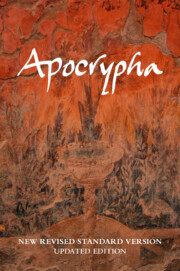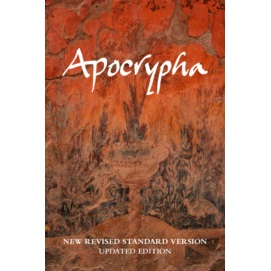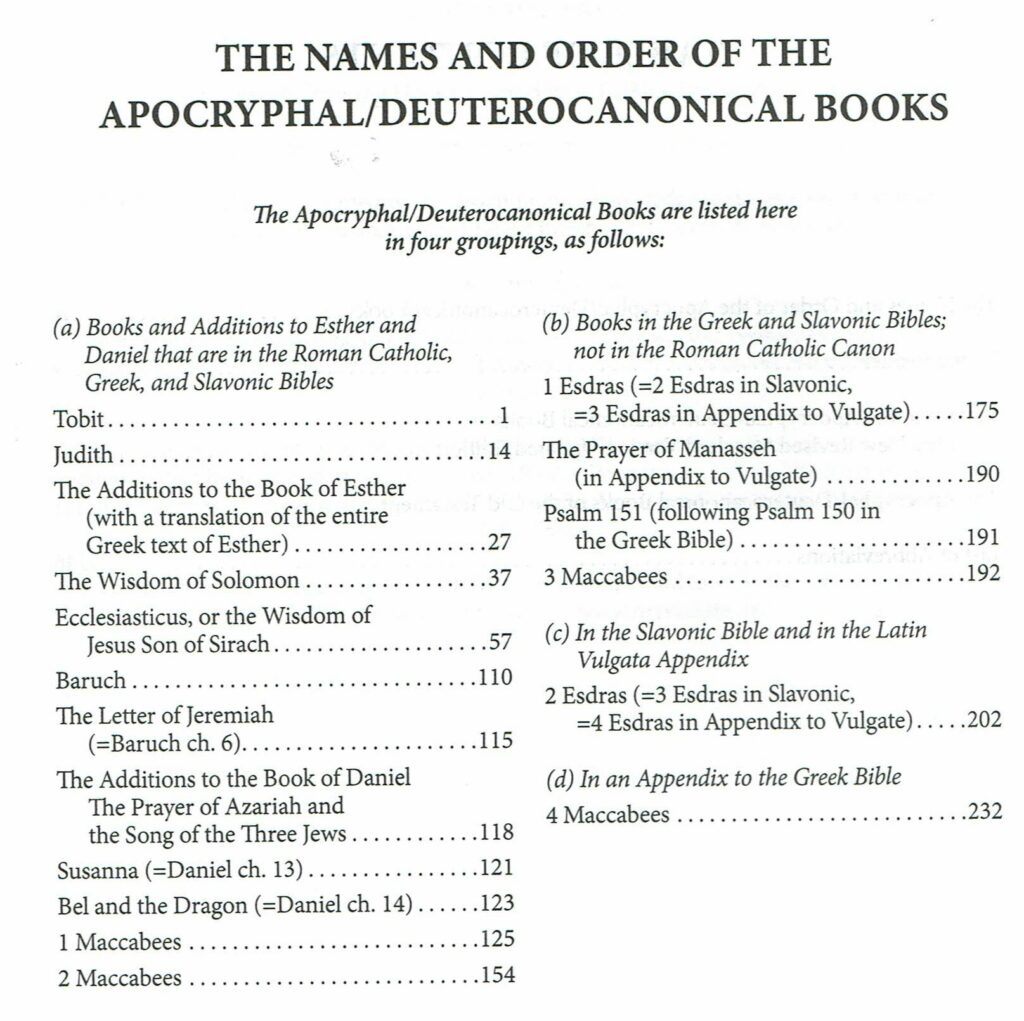This compact stand-alone edition of the New Revised Standard Version Updated Edition (NRSVue) Apocrypha is a precursor to the upcoming complete NRSVue to be released in 2024. The NRSVue Apocrypha preserves the accuracy and integrity of the NRSV while updating the language to modern English usage. It gives consideration to newer understanding of texts without creating a completely new translation.

The Apocrypha
New Revised Standard Version
Updated Edition
Cambridge University Press
November 2023
www.cambridge.org/bibles
This is a quality hardback book, nearly identical in appearance and construction to the stand-alone ESV Apocrypha released in March, 2021. It is a hardback book with a quality smyth-sewn binding, measuring about 6-1/4 by 9-3/8 inches and 9/16 inches thick.
Each book starts on a new page. The text is in paragraph format with two columns per page, and footnotes are at the bottom of each respective column on the page, easily identifiable by the verse number. According to the title page, the font is “9.5/10.5pt Minion Pro” but to me it looks a little smaller. It is very easy to read and there is no ghosting from other pages. The text appears to be line-matched, meaning the lines of text are in the same position on both sides of the page, preventing shadowing. Headings are bold, chapter numbers are clear and verse numbers do not distract from reading. Footnotes indicators also are not distracting, in lower-case superscript letters.
NRSVue Translation Principles
The Revised Standard Version (RSV) New Testament was published in 1946, and the RSV Old Testament in 1952. The Apocrypha published in 1957. Later, the New Revised Standard Version (NRSV) published in 1989. The National Council of Churches, which holds the copyrights, commissioned the Society for Biblical Literature to produce the New Revised Standard Version Updated Edition (NRSVue). According to the title page, the NRSVue is © 2021. This first edition of the NRSVue Apocrypha published this year, late 2023, and the complete NRSVue Bible is set to publish in the spring of 2024.
I found the “Preface to the Apocryphal/Deuterocanonical Books of the NRSV Updated Edition” to be one of the most interesting and well written that I have read. It goes into great detail about their use of the RSV and NRSV as the basis, giving consideration to modern discoveries and scholarship in critical texts. The preface also describes how the “Philological Revisions,” changes made so that modern English, which is itself changing, accurately reflect the meaning of the ancient languages.
The NRSVue took special care not to use terms in ways that are theologically or historically anachronistic, though, as in every translation, anachronism is unavoidable.
From the Preface to the Apocryphal/Deuterocanonical Books of the NRSV Updated Edition
Yet the thing that stands out most to me is the commitment not to turn this into a new translation. There are, according to the preface, “12,000 substantive edits and 20,000 total edits, which include grammar and punctuation.” I have to assume that these numbers apply to the entire NRSVue project, and not just this edition of the Apocrypha.
That leaves me a little bit curious. The English Standard Version is also a revision to the 1952 RSV. To me, the ESV seems to be a little closer than the 1989 NRSV to the original RSV, though the ESV has been through several revisions itself. I am looking forward to seeing the NRSVue in the spring. But for now, the focus here will be on this Apocrypha.
Content of the NRSVue Apocrypha
This stand-alone edition of the NRSVue Apocrypha consists of the same Apocryphal books found in the earlier RSV and NRSV. These are also the same books that were included in the ESV Apocrypha published in 2021. Th NRSV and NRSVue Table of Contents makes some important divisions and clarifications not found in the ESV Apocrypha that are extremely helpful.
The first 12 books are those found in the Deuterocanon of the Roman Catholic Church. And while in most Catholic Bibles these are integrated into the Old Testament, I am assuming that these will remain in a separate Apocrypha section when the complete NRSVue is published, as was done in the RSV and NRSV. It is interesting, though, that while the stand-alone edition of the ESV Apocrypha from Cambridge Bible Publishers remained as a separate section in the ESV Diadem Edition with Apocrypha, the English Standard Version Catholic Edition (ESV-CE) from the Augustine Institute incorporates them into the Old Testament similar to other Catholic Bibles.
In the NRSVue Table of Contents, the remaining books have very important explanations. There is a section of four books that are noted as “Books in the Greek and Slavonic Bibles, not in the Roman Catholic Canon,” a section described as “In the Slavonic Bible and in the Latin Vulgata Appendix,” and another as “In an Appendix to the Greek Bible.”
Further, 1 Esdras is properly identified as 2 Esdras or 3 Esdras in some Bible canons, and 2 Esdras as sometimes being called 3 Esdras or 4 Esdras. That is extremely helpful when you come across a reference to 2, 3, or 4 Esdras and are having difficulty finding it in context.
Tobit and Judith
For the book of Tobit, the New Revised Standard Version relied on the shorter Greek manuscript tradition; the NRSVue translated the longer Greek tradition (preserved in Codes Sinaiticus), while taking the Qumran manuscripts and other ancient witnesses into account.
From the Preface to the Apocryphal/Deuterocanonical Books of the NRSV Updated Edition
In simple terms, there are two Greek versions of this book (there are actually more, but they fall into these two categories). There is a shorter version, and a longer version by about 1700 words though there are other variations besides the additional words. Most English translations since the mid-1960s are based on the longer version which also takes into account findings in the Dead Sea Scrolls.
What I find confusing is that, while Tobit in the RSV was based on the shorter version, every copy of the NRSV that I have appears to use the longer version. I am not sure what this quote from the Preface is saying. I did contact the Society of Biblical Literature for an explanation, but have not yet received a response. It makes me wonder if portions of the NRSVue may actually be an update to the RSV rather than the NRSV.
To get a flavor of historical narrative in the NRSVue, I did a full comparison between the NRSV and NRSVue for both Tobit and Judith (and also 2 Esdras, which I will address later). I listened to an audio version of the NRSV Apocrypha while reading the NRSVue Apocrypha. Changes were relatively few, and they were more noticeable in Tobit than in Judith.
Updated language included more modern usage, for example “nations” rather than “gentiles.” In a few places I noticed that lines that were previously in footnotes were now in the text, and vice-versa, some things formerly in the text were now in the footnotes. I only made the comparison between NRSV and NRSVue, and it is pretty clear this is an update of the earlier translation. I did not check anything against other Apocrypha translations, such as the New American Bible, Revised Standard Version, or English Standard Version (which reads nearly identical to the original RSV).
Greek Esther
Like the NRSV, the NRSVue includes the entire Greek version of Esther as found in the Septuatint. There are differences between the Greek and Hebrew texts, including several portions not found in Hebrew.
Also following the tradition of the NRSV, the portions not found in Hebrew are given separate chapter numbers. The entire text does not flow numerically, but the chapter and verse numbers aren’t in the source text anyway. It reads as it should.
– Addition A – Chapter 11 (except verse 1) & Chapter 12
Esther 1:1 – 3:13
– Addition B – Chapter 13:1-7
Esther 3:14 – 4:17
– Addition C – Chapter 13:8-18 & Chapter 14
– Addition D – Chapter 15
Esther 5:3 – 8:12
– Addition E – Chapter 16
Esther 8:13 – 10:3
– Addition F – Chapter 10 & Chapter 11 (just verse 1)
For a variation on this see my review of the ESV Apocrypha
Most changes from the NRSV are updates in the English language, similar to others previously described. In comparing the NRSVue and NRSV I did find a few differences that go beyond the language. I am not certain what recently discovered texts may have been used for Esther, as this is the only book from the Hebrew scriptures not found in the Dead Sea Scrolls. Here are a few of the things I found.
Then the king examined the two eunuchs, and after they had confessed it, they were led away to execution.
Esther 12:3 NRSV Apocrypha
Then the king examined the two eunuchs, and after they had confessed it, they were led away.
Esther 12:3 NRSVue Apocrypha
The words “to execution” are deleted from the NRSVue. All other translations I checked state that they were executed. I am uncertain why the phrase “to execution” was deleted, though again I do not know what recently discovered texts were used. It isn’t likely this an attempt to water down the meaning for modern readers, as I am not finding any other indications this way.
When her parent’s died, he brought her up to womanhood as his own.
From Esther 2:7 NRSV Apocrypha
When her parent’s died, he brought her up as a wife for himself.
From Esther 2:7 NRSVue Apocrypha
This agrees with Brenton’s Septuagint and other translations from Greek. The Greek word is Strongs #G1135 gunē, and while it is the only word translated as “wife” in the New Testament, it is also more frequently just translated as “woman” even when the context is clear it is a married woman. It differs substantially from the Hebrew text, which uses the word #H1129 bat that definitely means “daughter.”
On that night the king could not sleep, and he gave orders to bring the book of records, the annals, and they were read to the king.
Esther 6:1 NRSV (canonical, from the Hebrew text)
That night the Lord took sleep from the king, so he gave orders to his secretary to bring the book of daily records, and to read to him.
Esther 6:1 NRSV Apocrypha
That night the Lord took sleep from the king, so he told his teacher to bring the book of daily records and to read to him.
Esther 6:1 NRSVue Apocrypha
This passage demonstrates one of the primary differences between the Greek and Hebrew texts other than length. It is frequently mentioned that the Book of Esther does not contain any mention of God, which is true in the Hebrew version. However, there are many references to God in the Greek version. This is just one of them.
Did the king call his secretary or his teacher? The Greek word is #G1249, diakonos, the basis for the New Testament ecclesiastical term “deacon.” Brenton translated it as “servant.” To me, “teacher” seems awkward. Diakonos is used in the Septuagint to translate two Hebrew words, #H5288 and #H8334, and the meaning here seems to be more of an attending servant. But again, these Greek translators know more about this than I do. I just find this an interesting choice.
One final observation in this passage, and one that can be see throughout the NRSVue Apocrypha, is the omission of the second comma before the final phrase. This is one result of the move to more modern usage of punctuation and sentence structure. One other interesting observation is that the “Oxford comma” appears in Azariah verse 23 – “stoking the furnace with naphtha, pitch, tinder, and brushwood” – and probably other places I did not check.
Sirach and Other Wisdom/Poetry Books
For this review I did not do a full comparison of the NRSVue with the NRSV on the remaining books (except 2 Esdras). That is a very time-consuming process, though worthwhile. Spot-checking a few extended passages, I did not find any significant or outstanding changes. As concerns style, these books follow similar updates as the others mentioned and as described in the Preface. They consist mostly of updated modern language, sometimes including word order, and in punctuation.
Most notable in the text is that several passages that were once rendered differently in the footnotes, or added/deleted in the footnotes, have had the previously footnoted reading placed in the Biblical text. In the same way, some passages previously in the text are now shown as footnotes. This is probably an indication of new understanding regarding the source texts, with which I am not familiar.
Here are examples of text moved to the footnotes:
He will find gladness and a crown of rejoicing, and will inherit an everlasting name.
Sirach 15:6 NRSV
Gladness* and a crown of rejoicing and an everlasting name he will inherit. Sirach 15:6 NRSVue
Footnote: 15.6 Other ancient authorities read He will find gladness
Sirach 15:6 NRSVue
…such a one is hateful to God and humans.*
Footnote: Other ancient authorities lack to God and humans
Sirach 20:15 NRSV
…such a one is hateful.*
Footnote: 20.15 Other ancient authorities add to God and humans
Sirach 20:15 NRSVue
Here are a few new footnotes in the NRSVue.
There is a cleverness that is exact but unjust, and there are people who abuse favors to gain a verdict.
Sirach 19:25 NRSV
There is a cleverness that is exact but unjust, and there are people who abuse favors to gain a verdict.
Footnote: Other ancient authorities add and the one who justifies is wise in judgment.
Sirach 19:25 NRSVue
Some people keep silent and are thought to be wise…
Sirach 20:5 NRSV
Some people keep silent and are found* to be wise…
Footnote: 20.5 Gk: Heb thought
Sirach 20:5 NRSVue
Do not be ensnared by a woman’s beauty, and do not desire a woman for her possessions.*
Footnote: Heb Syr: Other Gk authorities read for her beauty
Sirach 25:21 NRSV
Do not be ensnared by a woman’s beauty, and do not desire a woman for her possessions.*
Footnote: Heb Syr: Gk lacks for her possessions
Sirach 25:21 NRSVue
2 Esdras (sometimes 3 Esdras or 4 Esdras)
I included this book in my review because I have recently found it fascinating. See my article The Lying Pen of the Scribes in reference to chapter 14.
This book is a collection of visions by Ezra the Priest, many dealing with the afterlife, and some apocalyptic in nature. I encourage those who purchase this edition of the Apocrypha NRSV Updated Edition to read this book, which is not part of the Roman Catholic Deuterocanon and may not be familiar.
Viewing the differences in translation in the Updated Edition, I listened to the entire book in the NRSV as I was reading in the NRSVue. I again did not find anything notable. This is another book following the overall translation philosophy given in the Preface. There is some updated language and punctuation, particularly in the use of commas. “Hell,” a somewhat generic term in Christian usage, is more accurately rendered “Gehenna.” “Gentiles” is changed to “nations,” and “human beings” to just “humans.” It probably reads a little easier.
Conclusion
The New Revised Standard Version Updated Edition (NRSVue) Apocrypha from Cambridge University Press brings updated English grammar and punctuation to this well established translation. While there are a few textual changes of additional footnotes reflecting modern scholarship, this is not a new translation. The Society for Biblical Literature has done an outstanding job in reaching the goals stated in the Preface, and I am looking forward to seeing the complete Bible in 2024.
Cambridge University Press provided a complimentary copy of The Apocrypha – New Revised Standard Version Updated Edition for this review.


